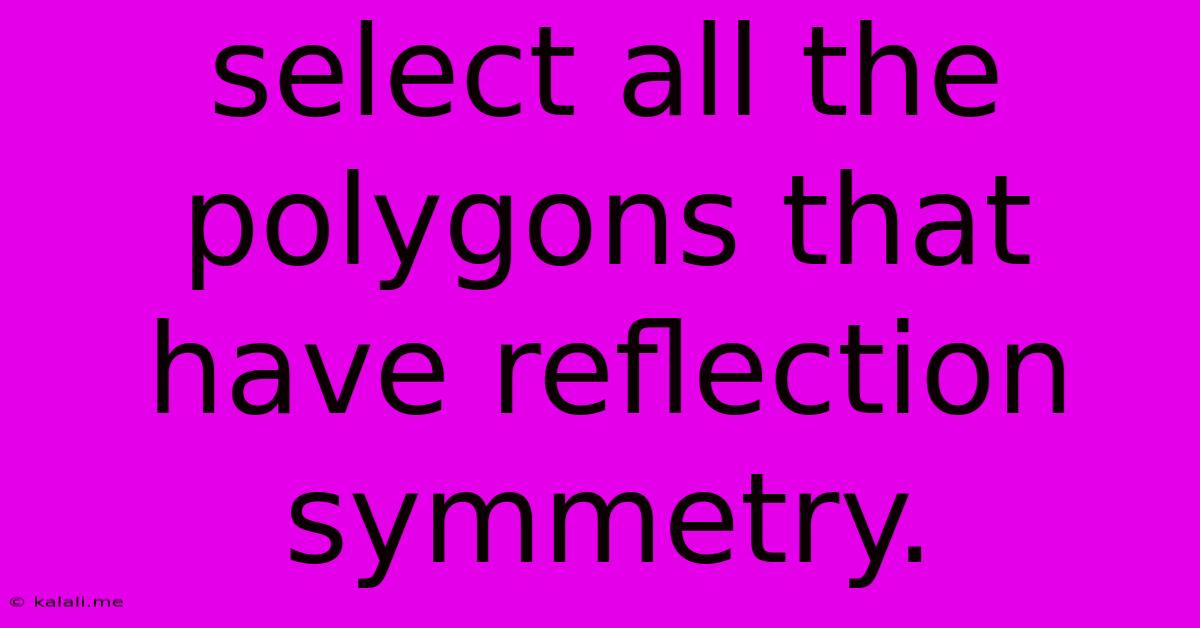Select All The Polygons That Have Reflection Symmetry.
Kalali
May 09, 2025 · 3 min read

Table of Contents
Select All the Polygons That Have Reflection Symmetry
Reflection symmetry, also known as line symmetry or mirror symmetry, occurs when a polygon can be folded along a line so that both halves match exactly. This line is called the line of symmetry or axis of symmetry. Not all polygons possess this property, and identifying which ones do involves understanding the shapes' characteristics. This article will explore various polygons and determine which exhibit reflection symmetry.
Understanding Reflection Symmetry in Polygons
To have reflection symmetry, a polygon must have corresponding sides and angles that are congruent when reflected across the line of symmetry. Think of it like a mirror image; one half is the exact reflection of the other. The number of lines of symmetry a polygon possesses can vary depending on its shape and regularity.
Polygons with Reflection Symmetry:
Let's examine several common polygons and assess their reflection symmetry:
-
Equilateral Triangle: This polygon has three lines of symmetry, each passing through a vertex and the midpoint of the opposite side.
-
Square: A square possesses four lines of symmetry: two lines connecting opposite vertices (diagonal symmetry), and two lines connecting midpoints of opposite sides.
-
Rectangle (excluding squares): Rectangles have two lines of symmetry, each running through the midpoints of opposite sides.
-
Regular Pentagon: A regular pentagon has five lines of symmetry, each line passing through a vertex and the midpoint of the opposite side.
-
Regular Hexagon: A regular hexagon boasts six lines of symmetry: three lines connecting opposite vertices and three lines connecting midpoints of opposite sides.
-
Regular Octagon: Similarly to other regular polygons, a regular octagon possesses eight lines of symmetry: four lines connecting opposite vertices and four lines connecting midpoints of opposite sides.
-
Rhombus (excluding squares): A rhombus has two lines of symmetry, each running through opposite vertices.
-
Isosceles Trapezoid: An isosceles trapezoid (a trapezoid with two equal sides) has one line of symmetry, running through the midpoints of the two parallel sides.
Polygons without Reflection Symmetry:
Not all polygons exhibit reflection symmetry. Examples include:
-
Irregular Triangles: Most triangles lack reflection symmetry unless they are equilateral or isosceles with specific angles.
-
Irregular Quadrilaterals: Quadrilaterals that don't fit the criteria of squares, rectangles, or rhombuses generally lack reflection symmetry.
-
Irregular Polygons: Any polygon with unequal sides and angles is unlikely to possess reflection symmetry.
Identifying Reflection Symmetry: A Practical Approach
To determine if a polygon has reflection symmetry, consider these steps:
-
Identify the shape: Determine the type of polygon (triangle, quadrilateral, etc.).
-
Look for congruent halves: Can you mentally fold the polygon in half so that both halves perfectly overlap?
-
Trace the line of symmetry: If you can fold it, trace the imaginary fold line. This is a line of symmetry.
-
Count the lines of symmetry: See how many lines can be drawn to create perfectly symmetrical halves.
Understanding reflection symmetry is crucial in various fields, including geometry, art, and design. By applying the concepts discussed above, you can confidently identify polygons with and without this type of symmetry. The key takeaway is to look for congruent halves formed by a line of reflection. Remember that regular polygons (with all sides and angles equal) always exhibit multiple lines of symmetry.
Latest Posts
Latest Posts
-
How Much Ml Is A Gallon
May 09, 2025
-
67 Out Of 80 As A Percentage
May 09, 2025
-
31 8 As A Mixed Number
May 09, 2025
-
Convert 425 Degrees Fahrenheit To Celsius
May 09, 2025
-
How To Calculate 25 Percent Of A Number
May 09, 2025
Related Post
Thank you for visiting our website which covers about Select All The Polygons That Have Reflection Symmetry. . We hope the information provided has been useful to you. Feel free to contact us if you have any questions or need further assistance. See you next time and don't miss to bookmark.